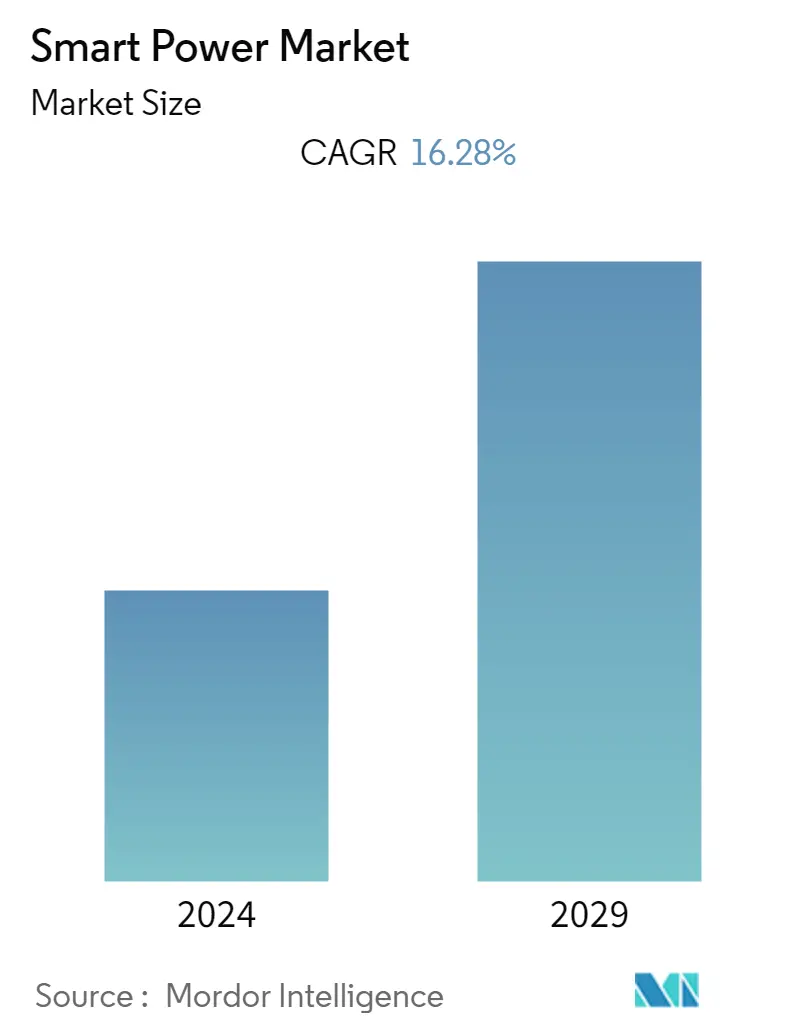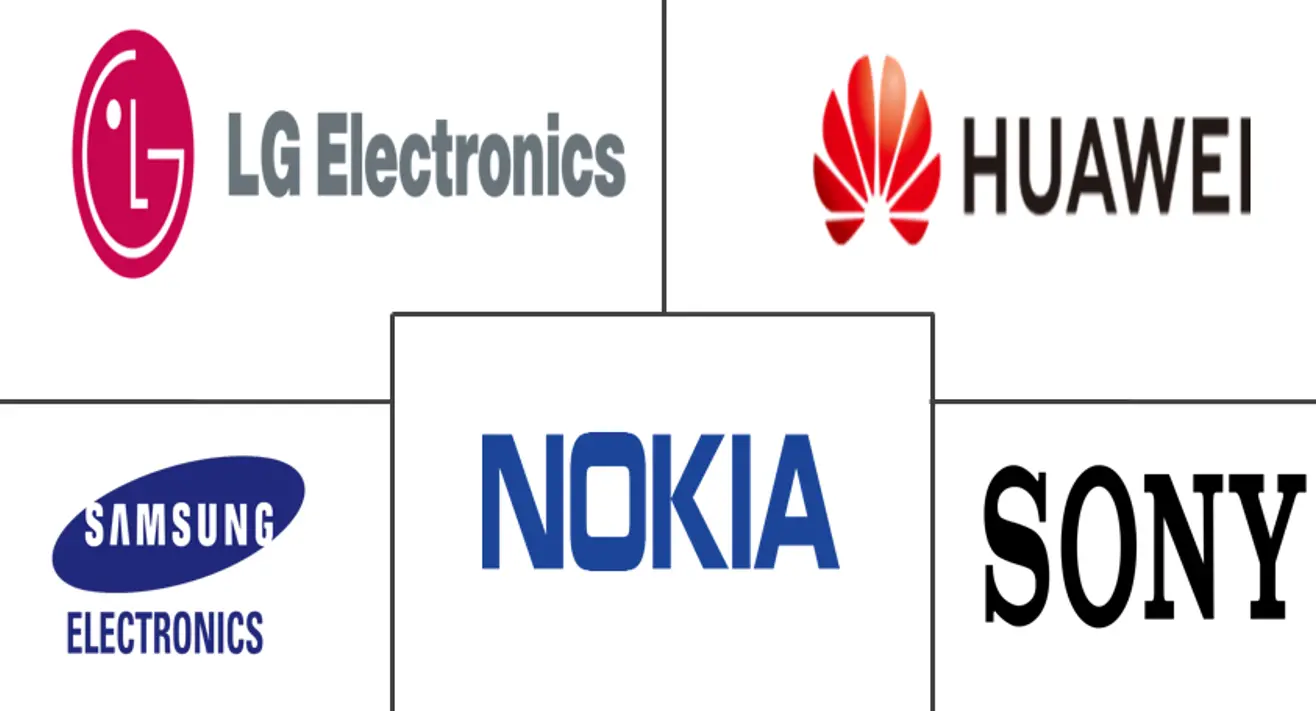Market Size of Smart Power Industry

| Study Period | 2019 - 2029 |
| Base Year For Estimation | 2023 |
| CAGR | 16.28 % |
| Fastest Growing Market | Asia Pacific |
| Largest Market | Asia Pacific |
| Market Concentration | Medium |
Major Players
*Disclaimer: Major Players sorted in no particular order |
Smart Power Market Analysis
The global smart power market (henceforth, referred to as the market studied) was valued at USD 7.67 billion in 2019, and it is projected to be worth USD 22.5 billion by 2025, registering a CAGR of 16.28% during 2020-2025. Wireless charging is an advanced technology of transmitting power through an air gap to electrical devices for energy replenishment. In the current market scenario, the recent progress in wireless charging techniques and commercial products' development has provided a promising alternative way to address the energy bottleneck of traditionally portable battery-powered devices.
- The incorporation of different wireless charging solutions into the existing wireless communication systems also presents a series of challenging issues with regard to scheduling, implementation, and power management, which act as major market restraints. Moreover, the market studied is gaining significant traction as this technology attracts a wide range of applications, from low-power toothbrushes to smartphones, because of its convenience and better user experience.
- In the recent past, wireless charging rapidly evolved from theories toward standard features on commercial products, especially mobile phones and portable smart home devices. In 2012, the Nokia 920 became the first smartphone with built-in Qi wireless charging capability; instead of using a wired battery charger, consumers could rest the smartphone on a wireless charging pad.
- Companies that currently offer wireless charging in smartphones (without an aftermarket product) include Apple, Samsung, Sony, LG, Nokia, Huawei, Microsoft, Google, and Blackberry. Wireless charging is also making inroads in laptops, although the adoption lags smartphones. The first wireless charging compatible laptop was Dell's Latitude 7285, which was introduced in the summer of 2017. Additionally, there are currently 18 car brands that offer wireless charging in cars, either as a standard option or an add-on solution.
- With the surging market penetration of wireless charging technologies, microwave beamforming has been adopted as a means to remotely power electronic products. The Qi specification, developed and supported by the Wireless Power Consortium (WPC), encompasses a combination of inductive charging and magnetic resonance technologies.
- Amidst the outbreak of COVID-19, the market is witnessing halting of production and disruption in the supply chain, leading to weakened growth of industrial output and the decline of wireless charger device manufacturing output across significant manufacturing hubs.
Smart Power Industry Segmentation
Wireless chargers can be embedded into various household fixtures. The study analyzes the current market scenario and key influencers for the smart power (wireless charging and energy management systems) market. The scope of the study includes the wireless chargers used for charging devices, such as smartphones, tablets, wearables, and other small consumer electronic devices; smart plugs; and energy management systems (EMS), a technology platform that controls, manages, and monitors home functions of various products in a residential setup (limited to only home EMS and excludes building EMS from the study). Market estimates are derived based on the demand for the product types, using a mix of top-down and bottom-up approach.
| Product | ||||
| ||||
|
| Geography | |||||||
| |||||||
| |||||||
| |||||||
| Rest of the World |
Smart Power Market Size Summary
The smart power market is experiencing significant growth, driven by advancements in wireless charging technologies and their integration into various consumer electronics. This market is characterized by the increasing adoption of wireless charging solutions across a wide range of devices, from smartphones to smart home gadgets. The convenience and enhanced user experience offered by these technologies are propelling their popularity. However, the market also faces challenges related to scheduling, implementation, and power management, which can hinder further adoption. Despite these challenges, the market is witnessing a surge in demand, particularly as major companies like Apple, Samsung, and Huawei continue to innovate and incorporate wireless charging capabilities into their products.
The market landscape is moderately fragmented, with a high intensity of competitive rivalry among key players such as Belkin International Inc., Nokia Corporation, and Sony Corporation. The global demand for smartphones, especially those with wireless charging features, is on the rise, with significant growth expected in regions like China, Japan, and South Korea. These countries are at the forefront of technological adoption, with China leading in smartphone user growth and the proliferation of 5G technology. The development of standardized wireless charging solutions has further facilitated the adoption of this technology across different devices and manufacturers. As the market evolves, companies are increasingly focusing on enhancing their offerings to capture a larger market share, with innovations like multi-device chargers and partnerships to improve product features.
Smart Power Market Size - Table of Contents
-
1. MARKET DYNAMICS
-
1.1 Market Overview
-
1.2 Industry Attractiveness - Porter's Five Forces Analysis
-
1.2.1 Bargaining Power of Suppliers
-
1.2.2 Bargaining Power of Consumers
-
1.2.3 Threat of New Entrants
-
1.2.4 Threat of Substitute Products
-
1.2.5 Intensity of Competitive Rivalry
-
-
1.3 Technology Snapshot
-
1.4 Impact of COVID-19 on the Wireless Charging Market
-
1.5 Market Drivers
-
1.5.1 Constantly Evolving Market for Smartphones, Wearables, and Other Portable Devices
-
-
1.6 Market Restraints
-
1.6.1 Technology is Expensive to Integrate and Comparatively Slower Charging
-
-
-
2. MARKET SEGMENTATION
-
2.1 Product
-
2.1.1 Wireless Chargers
-
2.1.1.1 Receivers (Applications Include Smartphones, Wearable Devices, and Computing Devices)
-
2.1.1.2 Transmitters (Applications Include Standalone, Hospitality, Furniture, Other Public Places, and Restaurants)
-
-
2.1.2 Energy Management Systems
-
2.1.2.1 Hardware (Hub Devices/Gateways, Smart Plugs, and Smart Clamps)
-
2.1.2.2 Software (Mobile and Dashboard Applications)
-
-
-
2.2 Geography
-
2.2.1 North America
-
2.2.1.1 United States
-
2.2.1.2 Canada
-
-
2.2.2 Europe
-
2.2.2.1 Germany
-
2.2.2.2 United Kingdom
-
2.2.2.3 France
-
2.2.2.4 Spain
-
2.2.2.5 Rest of Europe
-
-
2.2.3 Asia Pacific
-
2.2.3.1 China
-
2.2.3.2 Japan
-
2.2.3.3 Rest of Asia Pacific
-
-
2.2.4 Rest of the World
-
-
Smart Power Market Size FAQs
What is the current Smart Power Market size?
The Smart Power Market is projected to register a CAGR of 16.28% during the forecast period (2024-2029)
Who are the key players in Smart Power Market?
Samsung Electronics Co. Ltd , Sony Corporation , LG Electronics Inc. , Huawei Technologies Co. Ltd and Nokia Corporation are the major companies operating in the Smart Power Market.

